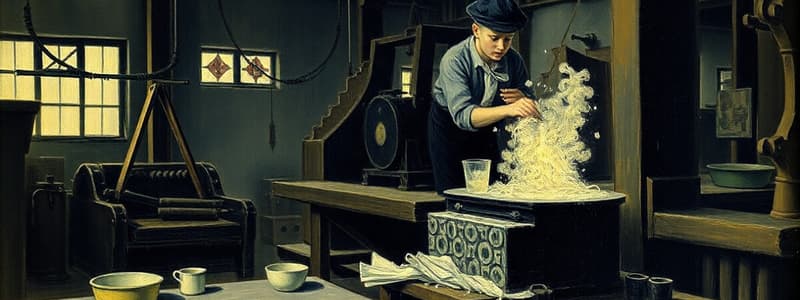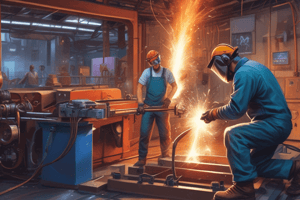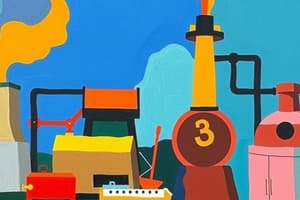Podcast
Questions and Answers
What is a key characteristic of discrete products in manufacturing?
What is a key characteristic of discrete products in manufacturing?
- They require high levels of automation to produce.
- They are made of continuous materials like wire spools.
- They are low-value-added products.
- They are individual items like nails or paper clips. (correct)
How does manufacturing contribute to the value of raw materials?
How does manufacturing contribute to the value of raw materials?
- It adds value by transforming raw materials into products with specific uses. (correct)
- It focuses on extracting the maximum amount of raw materials, disregarding waste.
- It standardizes the cost of all raw materials irrespective of their scarcity.
- It decreases the inherent value of raw materials to ensure affordability.
The term 'digital manufacturing' refers to:
The term 'digital manufacturing' refers to:
- the application of digital photography in quality control and inspection processes.
- manufacturing processes that rely primarily on manual labor and digitally printed instructions.
- the integration of powerful computers and software across the design and manufacturing enterprise. (correct)
- the use of traditional manufacturing techniques enhanced with digital marketing strategies.
What is a primary goal of concurrent engineering?
What is a primary goal of concurrent engineering?
Which aspect is a life cycle consideration in concurrent engineering?
Which aspect is a life cycle consideration in concurrent engineering?
What is the role of computer-aided engineering (CAE) in product design?
What is the role of computer-aided engineering (CAE) in product design?
Why are dimensional tolerances a major consideration in manufacturing?
Why are dimensional tolerances a major consideration in manufacturing?
Which of the following best describes 'Design for Manufacture (DFM)'?
Which of the following best describes 'Design for Manufacture (DFM)'?
What is a key consideration in design for service?
What is a key consideration in design for service?
What does 'green design and manufacturing' primarily focus on?
What does 'green design and manufacturing' primarily focus on?
What is the main principle behind 'design for recycling (DFR)'?
What is the main principle behind 'design for recycling (DFR)'?
Which of the following is a key factor in material selection for manufacturing?
Which of the following is a key factor in material selection for manufacturing?
What is a major aspect of material availability that affects manufacturing?
What is a major aspect of material availability that affects manufacturing?
What typically indicates a product has failed in service?
What typically indicates a product has failed in service?
What is a primary characteristic of net-shape manufacturing?
What is a primary characteristic of net-shape manufacturing?
What is the main function of computer-integrated manufacturing (CIM)?
What is the main function of computer-integrated manufacturing (CIM)?
In the context of computer-integrated manufacturing (CIM), what is the role of adaptive control (AC)?
In the context of computer-integrated manufacturing (CIM), what is the role of adaptive control (AC)?
What is the core principle behind Just-in-Time (JIT) production?
What is the core principle behind Just-in-Time (JIT) production?
What is the primary objective of cellular manufacturing?
What is the primary objective of cellular manufacturing?
What is the main goal of quality assurance and total quality management (TQM) in manufacturing?
What is the main goal of quality assurance and total quality management (TQM) in manufacturing?
What does the term 'product integrity' generally define?
What does the term 'product integrity' generally define?
What is a key aspect of lean production?
What is a key aspect of lean production?
What does 'benchmarking' involve in manufacturing?
What does 'benchmarking' involve in manufacturing?
What is a major factor driving the increasing importance of manufacturing economics?
What is a major factor driving the increasing importance of manufacturing economics?
Which of the following factors affects raw material costs in manufacturing?
Which of the following factors affects raw material costs in manufacturing?
Besides cutting tools, dies, and fixtures, what do tooling costs include?
Besides cutting tools, dies, and fixtures, what do tooling costs include?
What do fixed costs in manufacturing typically include?
What do fixed costs in manufacturing typically include?
What differentiates direct labor from indirect labor in manufacturing costs?
What differentiates direct labor from indirect labor in manufacturing costs?
In regards to the history of manufacturing, what was a major milestone achieved during the Roman Empire (500 B.C. to 476 A.D.)?
In regards to the history of manufacturing, what was a major milestone achieved during the Roman Empire (500 B.C. to 476 A.D.)?
How did manufacturing change as a result of interchangeable parts introduced in the early 1800s?
How did manufacturing change as a result of interchangeable parts introduced in the early 1800s?
What material development marked a significant milestone in the period of 600-800 A.D. in Asia?
What material development marked a significant milestone in the period of 600-800 A.D. in Asia?
What initial advantage did the United States have from the 1940s to the 1960s that allowed it to dominate mass production?
What initial advantage did the United States have from the 1940s to the 1960s that allowed it to dominate mass production?
What is the role of design and manufacturing teams in addressing product liability?
What is the role of design and manufacturing teams in addressing product liability?
What's a typical cause for a shortened service life of a product?
What's a typical cause for a shortened service life of a product?
What’s an environmental concern directly related to the waste products of manufacturing?
What’s an environmental concern directly related to the waste products of manufacturing?
What does the economic aspect of material selection emphasize?
What does the economic aspect of material selection emphasize?
What benefits does producing aluminum from recycled scrap provide compared to producing it from bauxite ore?
What benefits does producing aluminum from recycled scrap provide compared to producing it from bauxite ore?
Why has selecting the appropriate material for a very specific application become increasingly challenging?
Why has selecting the appropriate material for a very specific application become increasingly challenging?
How does weight minimization affect aerospace and automotive applications?
How does weight minimization affect aerospace and automotive applications?
Flashcards
Manufacturing
Manufacturing
The process of building and assembling individual pieces into finished goods.
Discrete Products
Discrete Products
Individual items, like nails or paper clips.
Continuous Products
Continuous Products
Products produced in a continuous flow, like wire or tubing.
High-Value-Added Products
High-Value-Added Products
Products with significantly increased value after manufacturing.
Signup and view all the flashcards
Concurrent Engineering
Concurrent Engineering
Designing a product while concurrently considering all aspects of its life cycle.
Signup and view all the flashcards
Product Design
Product Design
The systematic creation of the shape and characteristics of an item.
Signup and view all the flashcards
Design for Manufacture (DFM)
Design for Manufacture (DFM)
Designing a product for easy manufacturing, assembly, disassembly, and service.
Signup and view all the flashcards
Green Design and Manufacturing
Green Design and Manufacturing
Designing products with environmental impact in mind.
Signup and view all the flashcards
Biological Cycle (Recycling)
Biological Cycle (Recycling)
The process where organic materials degrade naturally.
Signup and view all the flashcards
Industrial Cycle (Recycling)
Industrial Cycle (Recycling)
The closed-loop recycling and reuse of materials.
Signup and view all the flashcards
Material Properties
Material Properties
Mechanical properties like strength and ductility.
Signup and view all the flashcards
Resource self-reliance
Resource self-reliance
Self-reliance on resources.
Signup and view all the flashcards
Geopolitics
Geopolitics
The study of geography's impact on a nation's foreign policy.
Signup and view all the flashcards
Net-Shape Manufacturing
Net-Shape Manufacturing
A measure to evaluate modern production processes.
Signup and view all the flashcards
Computer-Integrated Manufacturing (CIM)
Computer-Integrated Manufacturing (CIM)
Blending computer-aided design, modeling and manifacturing.
Signup and view all the flashcards
Adaptive Control (AC)
Adaptive Control (AC)
A method to reduce costs.
Signup and view all the flashcards
Lean Production
Lean Production
Reducing waste in all production-related processes.
Signup and view all the flashcards
Benchmarking
Benchmarking
When a manufacturer compares its operations.
Signup and view all the flashcards
Raw-Material Costs
Raw-Material Costs
Costs that depend on the resource.
Signup and view all the flashcards
Tooling Costs
Tooling Costs
Includes costs for cutting tools, dies, molds, work-holding devices, and fixtures.
Signup and view all the flashcards
Fixed Costs
Fixed Costs
Rent for facilities, insurance, and real-estate taxes.
Signup and view all the flashcards
Capital Costs
Capital Costs
Production machinery, equipment, buildings, and land.
Signup and view all the flashcards
Direct Labor Costs
Direct Labor Costs
Concerns the labor that is directly involved in manufacturing products.
Signup and view all the flashcardsStudy Notes
- Most objects consist of numerous pieces built and assembled by manufacturing processes.
- Manufacture first appeared in English in 1567, derived from the Latin "manu factus", meaning "made by hand."
- Manufacturing first appeared in 1683 and production appeared in the 15th century.
- Discrete products are individual items (nails, bolts, paper clips).
- Continuous products are continuous materials cut to specific lengths (wire, tubing, aluminum foil).
- Manufactured items gain value through processing raw materials.
- High-value-added products include computer chips, electric motors, medical implants, machine tools, and aircraft.
Brief History of Manufacturing
- Manufacturing dates back to 5000-4000 B.C., predating recorded history.
- Early manufacturing includes cave drawings, markings on clay tablets and stone.
- Ironmaking began in the Middle East (1100 B.C.), steel production in Asia (600-800 A.D.).
- Diverse materials are available, including engineered materials, high-tech ceramics, reinforced plastics, composites, and nanomaterials.
- Until the Industrial Revolution in England (1750s), goods were produced in batches with manual labor.
- The Second Industrial Revolution began in the mid-1900s with solid-state electronics and computers.
- Mechanization began in England and Europe with textile machinery and machine tools.
- Interchangeable parts design began in the early 1800s by E. Whitney.
- Mass production and global markets characterized manufacturing from the 1940s-1990s.
- Digital manufacturing began around 1990, integrating computers and software across design and manufacturing.
Product Design and Concurrent Engineering
- Product design prescribes the shape and characteristics of an artifact.
- Design decisions determine 80% of product development and manufacturing costs.
- Successful design requires clear functions, performance expectations, and market analysis.
- Traditional design involved sequential activities, which may be wasteful.
- Concurrent engineering aims to bring products to market rapidly, involving simultaneous consideration of all disciplines.
- Communication among disciplines is critical in concurrent engineering.
- Concurrent engineering is applicable to companies of all sizes.
- Product life cycle has four stages: product start-up, rapid growth, product maturity, and decline.
- Life-cycle engineering considers the entire product life, from design to disposal.
Computers in Product Design
- Product design uses analytical and physical models for visualization and analysis.
- Models are simplified with computer-aided design (CAD) and computer-aided engineering (CAE).
- CAD systems enable rapid design analysis (e.g., Boeing 777 designed completely by computers).
- Computer-aided engineering simulates performance under various conditions.
- Computer-aided manufacturing involves all phases, utilizing stored information on materials and processes.
- Computers assist with programming, tool design, and quality control.
- Designers finalize geometric features, dimensional tolerances, and surface-finish.
Prototypes
- Prototypes are physical models reviewed for design/production modifications.
- Rapid prototyping enables quick and low-cost prototype creation.
Design for Manufacture, Assembly, Disassembly, and Service
- Design for manufacture (DFM) integrates design with production methods and materials.
- DFM requires understanding materials, processes, machinery, and variability.
- Quantitative relationships are essential for design optimization.
- Design for assembly (DFA), design for manufacture and assembly (DFMA), design for disassembly (DFD) are important.
- Assembly costs range from 10-60% of the total product cost, making ease and speed important.
- Disassembly is important for maintenance, servicing, and recycling.
- Design for service involves easy access to components needing service.
Green Design and Manufacturing
- Discarded items includes: 9 million cars, 300 million tires, 670 million lamps, and 5 billion kg of plastics annually in the US.
- Manufacturing processes and machinery impact the environment.
- Wastes produced by manufacturing include chips, slag, additives, hazardous waste, lubricants, liquids, and solvents.
- Environmental concerns include global warming, acid rain, ozone depletion, and pollution.
- Carbon footprint quantifies greenhouse gases produced.
- Green design and manufacturing considers environmental impacts of materials, processes, and operations.
- Design for recycling (DFR) involves biological or industrial cycles.
- Biological cycle: organic materials degrade naturally.
- Industrial cycle: materials are recycled and reused.
- Aluminum recycling from scrap reduces costs by 66% and energy consumption/pollution by 90%.
- About 75% of automotive parts are recycled in the U.S.
Selection of Materials
- A wide variety of materials are available with different properties, characteristics, advantages, and costs.
- Material selection is done with materials engineers and design engineers.
- General types of materials:
- Ferrous metals: Carbon, alloy, stainless, tool and die steels.
- Nonferrous metals: Aluminum, magnesium, copper, nickel, titanium, superalloys, refractory metals, beryllium, zirconium, low-melting-point alloys, and precious metals.
- Plastics (polymers): Thermoplastics, thermosets, elastomers
- Ceramics, glasses, glass ceramics, graphite, diamond, and diamondlike materials.
- Composite materials: Reinforced plastics, metal-matrix, ceramic-matrix composites.
- Nanomaterials
- Shape-memory alloys, amorphous alloys, semiconductors, superconductors.
- Material selection is challenging due to new developments and material substitution.
- Mechanical properties of interest include strength, ductility, hardness, toughness, elasticity, fatigue, and creep resistance.
- Physical properties of interest are density, specific heat, thermal expansion & conductivity, melting point, and electrical & magnetic properties.
- Optimal designs need a combination of mechanical and physical properties.
- Chemical properties like oxidation, corrosion, degradation, toxicity & flammability are important.
- Manufacturing properties indicate how a material can be cast, formed, machined, joined, and heat treated.
Availability of Materials
- Economic aspects are important for material selection.
- Supply reliability is important to maintaining production schedules, particularly in automotive industries.
- Geopolitics and a country's self-reliance on resources must be considered.
- Shortened product service life can result from material selection, production methods, control of variables, or defects.
- A product fails when it stops functioning, does not perform, or becomes unsafe.
Selection of Manufacturing Processes
- There are multiple methods to produce a component from a material.
- Broad categories of manufacturing:
- Casting: Expendable mold and permanent mold.
- Forming and shaping: Rolling, forging, extrusion, drawing, sheet forming, powder metallurgy, molding.
- Machining: Turning, boring, drilling, milling, planing, shaping, broaching, grinding, ultrasonic, chemical, electrical, electrochemical machining, and high-energy-beam machining.
- Joining: Welding, brazing, soldering, diffusion bonding, adhesive bonding, and mechanical joining.
- Finishing: Honing, lapping, polishing, burnishing, deburring, surface treating, coating, and plating.
- Microfabrication and nanofabrication: Fabrication of microelectromechanical and nanoelectromechanical systems.
Net-Shape and Near-net-Shape Manufacturing
- Net-shape and near-net-shape manufacturing make a part close to the final dimensions, tolerances, and surface finish.
- Additional operations such as machining or grinding may be needed, contributing to product cost.
Computer-Integrated Manufacturing
- Computer-integrated manufacturing (CIM) integrates software and hardware for graphics, modeling, design, and manufacturing.
- CIM began in the 1970s and enhances responsiveness, material use, and production control.
CIM Elements
- Computer numerical control (CNC): controlling machine movements with coded instructions.
- Adaptive control (AC): automatically adjusting parameters to optimize quality and minimize costs.
- Industrial robots: replacing humans in repetitive or dangerous tasks.
- Automated materials handling: using computers for material and component handling.
- Automated assembly systems: replacing humans in assembly.
- Computer-aided process planning (CAPP): optimizes process planning for productivity and consistency.
- Group technology (GT): grouping parts based on design and manufacturing similarities.
- Just-in-time production (JIT): delivering supplies and producing parts just in time.
- Cellular manufacturing (CM): utilizing workstations with manufacturing cells.
- Flexible manufacturing systems (FMS): integrating manufacturing cells with a central computer.
- Expert systems (ES): computer programs with problem-solving capabilities.
- Artificial intelligence (AI): computer-controlled systems that learn from experience.
- Artificial neural networks (ANN): simulating human thought processes for production and financial planning.
Quality Assurance & Total Quality Management
- Product quality influences satisfaction and success.
- Quality must be built into the product from design through manufacturing.
- Continuous control of processes (online monitoring) is critical.
- Quality assurance and total quality management (TQM) is a shared responsibility.
- Product integrity is the degree to which a product functions reliably, is suitable, and can be maintained.
- Designing and manufacturing safe products is a manufacturer's responsibility, as is avoiding failure due to misuse.
- A product's malfunction or failure causes bodily injury, death, or financial loss.
- Product Liability is the laws governing product failure and its consequences.
Lean and Agile Manufacturing
- Lean production minimizes waste at all levels by eliminating unnecessary operations.
- Lean production focuses on manufacturing steps, machinery, and personnel.
- Agile manufacturing requires agility and flexibility to respond to changes in product demand.
- Achieving flexibility: with people, equipment, computer hardware, software, and communications systems.
Methodologies
- Lean and agile production require benchmarking.
- Benchmarking: assessing competitive position (product quality, production time, manufacturing costs) and setting realistic goals.
Manufacturing Costs
- The economics of manufacturing are critical, with global competition and demand for high-quality, low-priced products.
- Manufacturing cost represents 40% of the selling price.
Cost Components
- Materials: raw-material costs depend on the material itself and on supply and demand.
- Tooling: costs for cutting tools, dies, molds, work-holding devices, and fixtures.
- Fixed, costs include: energy, rent for facilities, insurance, and real-estate taxes.
- Capital, costs include: Production machinery, equipment, buildings, and land.
- Labor, cost consists of: direct and indirect costs.
Studying That Suits You
Use AI to generate personalized quizzes and flashcards to suit your learning preferences.





